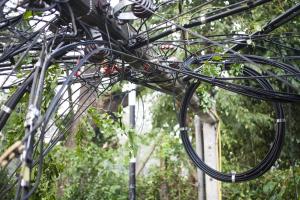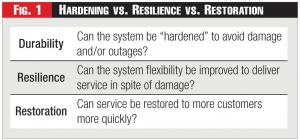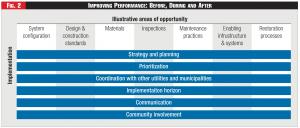Taking Resiliency One Step Further
Mike Hervey is Director of Navigant’s Energy Practice, in the firm’s New York City office. Since joining Navigant in early 2013, he has performed end-to-end analyses of business processes, culture, work practices, and geographical differences across energy service companies. Before joining Navigant, Mr. Hervey was Chief Operating Officer and Acting CEO of the Long Island Power Authority.
Rising customer reliance on energy for daily needs. More dramatic weather patterns. A heightened sensitivity to the costs of extended utility outages. Regulatory pressures growing more intense. Each of these factors is driving utility asset owners increasingly to consider formalized programs for utility system hardening.

Recent events - including hurricanes, ice storms, derechos, and even fires - have shown that regulators and customers will no longer tolerate extended electric system outages. The political, regulatory, and customer outcries during, and after, each major prolonged outage incident are growing at an ever-increasing pace. Yet relatively little is actually being done to harden electric systems in most areas of North America.
Several states, including Florida, Texas, Oklahoma, and Kentucky, have forged the the way with prescribed regulatory requirements, many of which have existed for some time. However, the regulatory environment around utility system hardening remains cautious and inconsistent. When considering a system hardening program, utilities should ask a wide range of questions: Which programs will provide the best outcomes for the optimal spend? What should our hardening priorities be? And, what costs can be recovered in rates?
For their part, regulators also tend to have limited experience with system hardening measures. Consequently, they often focus on very narrow solutions - the overall result often being that the best solutions are not what regulators, utilities, or their customers might perceive them to be. Often, as these programs are considered, there is not enough focus on how to best accomplish specific goals or look at a broad enough range of opportunities to improve system performance.
Unfortunately, the regulated programs that currently exist generally focus on a narrow range of potential types of damage and/or hazards that historically are seen only in very specific geographic areas. In recent years, however, there has been an effort to define problems and potential solutions more broadly, with much of the discussion focused on "resiliency." Resiliency is a helpful concept as far as it goes. It describes the efforts needed to improve a system's ability to bounce back after a major damaging event without over-promising that damage can be completely avoided or eliminated. The term "resiliency" also mirrors the vocabulary used by federal emergency management experts. "Resiliency", however, can be unhelpful for what it fails to do. While it focuses on bouncing back, essentially as a reaction to any single event, resiliency as a strategy can sometimes ignore or overlook opportunities to prevent damage and mitigate a storm's impact in the first place. That is why, from a program perspective, while resiliency may sound good for public consumption, the industry nevertheless should think in much broader terms.
 Figure 1 - Hardening vs. Resilience vs. Restoration
Figure 1 - Hardening vs. Resilience vs. Restoration
Realistically, if asset owners and regulators want to address the issue of utility system hardening in a way that manages both expectations and costs, they must consider a wide range of hazards - including hurricanes, tidal and storm surges, fire, ice, tornados, earthquakes, floods, and man-made disasters -while simultaneously considering a very broad approach to reinforcing systems, components, processes, and procedures. Where system hardening requirements are not currently prescribed by regulation, a customized approach can be developed so that hardening programs can address both the various types of major events that can potentially occur and the types of damage that can result. And don't forget that system hardening is a relatively new concept. Most asset owners have little information that can be used as a basis for developing an effective program.
Rethinking Your Objectives
Because storm hardening addresses very specific yet infrequent major events, cost and benefits are very difficult to quantify. Storm hardening programs can rarely be justified using typical utility cost/benefit analysis methodologies.
For example, whether or not a storm hardening program actually decreases the number or duration of outages is difficult to predict, and even harder to verify since system reaction to every storm is different. Similarly, the time that passes between applying storm hardening measures and a major damaging event could be years. And even with hardening in place, Mother Nature is unpredictable, and can always cause damage that could not be predicted or practically addressed. The costs associated with storm hardening programs are great. Yet the benefits are not only difficult to quantify, and but often only incremental to what the result might have been for any specific event, without the hardening program. Therefore, system hardening is more often justified on policy goals that are directed towards protecting a company's physical assets and limiting exposure or risk from the customer's perspective. A comprehensive policy statement, then, should include discussion of the following objectives:
 Figure 2 - Improving Performance: Before, During and After
Figure 2 - Improving Performance: Before, During and After
• Decrease the number of outages,
• Decrease restoration time,
• Limit the amount of damage to the system,
• Protect the most valuable and hard to replace assets (thus limiting cost exposure and operating risk), and
• Keep service on for critical infrastructure
This generic, five-part objective statement can be further focused with quantities, times, durations, and other specifics in order to adapt it to a particular utility's situation or regulatory environment. However, by its nature, the objective statement also acknowledges that outages cannot be reduced to zero in every circumstance, restorations do take time, some assets are so vital that they require special treatment, and utilities may need to know quite a bit more than they know today about the criticality of customers that are being served.
While the first two objectives may be obvious to most, the second two objectives are often overlooked by regulators and utilities, and require utilities to look beyond distribution assets. The process of protecting the most valuable and hard-to-replace assets leads directly to having specific assessments, risk evaluations, design improvements, and mitigation programs for some of the most expensive utility assets. Illustrative examples of assets in this category include substation equipment, underground transmission systems that have dielectric fluid, and overhead transmission spans that are difficult to reach because of their isolated location, complexities or coordination with other agencies such as railroads, or that require specialty equipment to repair such as long river crossings.
Keeping electric service on for critical infrastructure means that utilities must spend a significant amount of time with local emergency management agencies to assess, inventory, and understand customer criticality from an emergency management perspective. Significantly, these emergency management criteria are very often very different than most regulator-defined critical or medical customer lists. Customers that could be included on an emergency management critical list include water and sewer stations, government centers, cooling centers, evacuation centers, transportation hubs, schools, bridges and tunnels, commuter railroads, liquid fuel infrastructure, waste water pumping stations, and communications systems. Knowing the various risks for these types of customers, and the importance of each to emergency management professionals, can not only provide a framework for prioritizing system hardening and restoration, but can also push utilities beyond their normal approach to system design and restoration priorities. Additionally, having a well thought out and prepared plan developed in conjunction with the emergency management professionals can also provide support for regulatory relief from any additional costs associated with providing higher levels of service to these types of facilities.
A Concrete Approach
Given what is at stake as a result of the high costs, complexity, and potential impacts on customers, a broad-reaching but disciplined approach to analyzing system hardening programs and opportunities is required. And, because of geographic variations and differences in the design basis of utilities, a customized approach to determining the best hardening solutions for a particular utility in any particular situation is most often in order. This also means that the process of developing a program starts with each utility conducting a review of its specific situation relative to best practices and opportunities for improvement. This customization also means that, for example, even within a given utility, the risks and opportunities between coastal and inland or metropolitan and rural areas are evaluated differently. This type of customized approach reviews hardening opportunities under a three-part lens designed to probe whether or not system performance and service quality in response to severe storms can be improved.
While the current industry conversation focuses on resilience, don't ignore the durability and restoration aspects of a system hardening program. By focusing on durability - making changes in an coordinated and integrated fashion where damage can be avoided - the system becomes more flexible (resilience) and service is restored more quickly (restoration). This more comprehensive result will improve performance across a wider range of every day events than would occur in a program that would be more focused but only address sporadic major damage events.
In other words, by taking a broader approach to hardening for major events that also improves system performance for more frequent events, the program assures that benefits are observed not only more frequently, but are also more quantifiable, and over a shorter period of time. And, when benefits are more readily observed, the program can be fine-tuned or optimized over time with the resulting program being customized, well-structured and broad-based, with a strong basis for regulatory support. Utilizing this three-pronged approach also promotes the use of a full range of operational changes, process improvements, procedural updates, and other measures in addition to simply beefing up system design, thus creating pathways to optimize solutions.
Areas of Opportunity
Once a utility establishes policy objectives for its system hardening program, there are generally six broad areas of opportunity that are key to improving the system performance before, during, and after major damage events.
1. System Configuration.
2. Design/Construction Standards.
3. Materials.
4. Inspections.
5. Maintenance Practices.
6. Enabling Infrastructure.
System Configuration. This area of opportunity Includes planning, configuring, and actively re-configuring the system, both in day-to-day operation and design, so that risk from loss of one or more components is minimized and there is a viable path to recovery in the event of one or more elements of the system failing. Top examples include the pervasive use of distribution automation, a high degree of operational awareness, robust command and control systems, and a real time risk assessment and management of the current configuration of the distribution system from the customer's perspective.
Design/Construction Standards. These measures may include higher wind- and ice-loading criteria, or sealing substation equipment from water and snow intrusion. Construction standards may require hardened assets in new construction, focused high-value enhancements to non-hardened assets, or construction standards that enhance assets and simplify their reparability. Design standards can include redundancy, operability, selective undergrounding, submersible underground equipment, engineered failure points on distribution lines, raising the height of substations or substation equipment, and moving the physical location of facilities to less vulnerable areas out of flood and surge zones.
Materials. The hardening program may intentionally and selectively require using stronger and more durable materials that have a higher likelihood of survival in extreme conditions. Examples include substation insulator materials that can withstand direct strikes from wind-blown debris, steel pole construction, stainless steel transformer tanks in salt water areas, and improved gasket and weather-proofing materials for control cabinets.
Inspections. System hardening includes performing appropriate inspections of potentially vulnerable assets to proactively identify them for replacement or repair with system hardening requirements in mind. Inspection activities include inspecting substation and control equipment for water tightness, improved pole inspection and replacement programs, and remote monitoring of equipment that is difficult to access.
Maintenance Practices. Hardening may prescribe enhanced maintenance practices designed to reduce susceptibility to damage or aid in reconfiguration of the delivery system. Maintenance practices can include hazardous tree removal, removing over-hanging tree limbs, keeping underground and overhead looped systems fully operational, and exercising switching equipment.
Enabling Infrastructure. The program also may include designing, preparing, and testing of infrastructure and systems critical to operational awareness and outage restoration for volume levels well above normal expectations, and for maintaining a very high availability that ensures continuity of service in the most extreme situations. This includes capabilities such as redundant command and control locations, remote monitoring, system control and data acquisition, Distribution Management Systems, radio communications, Information Technology Systems, customer call systems, and telecommunications.
Organizational Aspects
While the design, maintenance, condition, and configuration of the delivery assets are clearly key to improving system hardening, there are five organizational aspects to system hardening that must also be addressed:
1. Strategy and Philosophy.
2. Prioritization.
3. Coordinating Implementation.
4. Communication.
5. Community Involvement.
Strategy and Philosophy. The program strategy and philosophy should define the sequencing of components of the program over a defined number years by company or regulatory objectives. It also should define the relationships that are expected with emergency managers and civil authorities, business plans for execution of the program, funding mechanisms, rate impact, and dealing with regulatory needs.
Prioritization. This process should prioritize opportunities, especially between organizational silos. At a minimum, priorities should be reevaluated annually, based on the progress of the project, as well as the expected and observed results. Prioritization allows for otherwise disparate work to be compared (e.g., pole replacement compared to IT system enhancement) to set program schedules and funding.
Coordinating Implementation. Coordinating the timing of roll-out of the different phases of the program is essential, as well as sequencing the enhancement programs with other significant entities that share the same geography. Implementation horizons should be set primarily on the previously described strategy and philosophy, but should also be coordinated with emergency management professionals, other utilities such as water and communication companies, government agencies and transportation authorities, and modernization or hardening upgrade programs that critical customers may be planning for themselves.
Communication. Communicating program details includes setting expectations with stakeholders. Clearly communicating program expectations, progress, and results to customers, employees, regulators, government agencies, and critical customers is vital and should be carried out through a defined and coordinated communication plan.
Community Involvement. Gaining community acceptance includes being open to community input regarding system enhancements. Creating and maintaining strong relationships with emergency managers, local governments, government agencies, and communities is required in order to understand the point of view of these critical customers. Keeping these stakeholders informed about program progress and results, as well as managing their expectations on an ongoing basis, is critical to the success of any system hardening program.
Pulling the Program Together
Hardening a utility system is necessary and detailed work that touches nearly every aspect of utility operations. Beginning with the development and refinement of objectives, and leading to asset enhancement and organizational change, optimized hardening programs look beyond the programs that regulators have mandated and that most utilities have implemented.
System hardening also represents a significant set of changes in the underlying approach that utilities take regarding assets and organization. That means deploying processes to manage the changes, both internally and externally.
Finally, a well prepared program that incorporates all of the aforementioned concepts can provide an excellent basis for developing the regulatory support needed for significant investment to occur. For that to happen, the program should include an assessment of the current system assets and applicable business processes though use of a well thought out diagnostic tool. The system hardening program also should feature defined objectives, a detailed plan for implementation, funding, and execution, and lastly, continuous monitoring for effectiveness.

